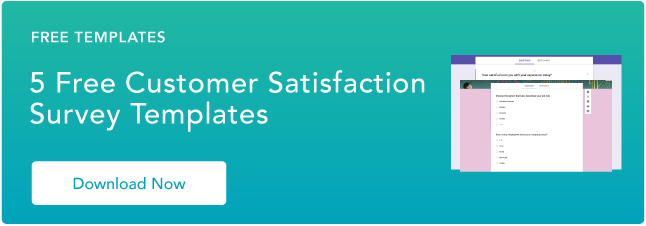In this post, we'll discuss what concept testing is and explain the different methods you can use to test ideas at your business.
Skip to:
- What is Concept Testing?
- Benefits of Concept Testing
- Concept Testing Methods
- Concept Testing Survey
- Concept Testing Examples
What is concept testing?
Concept testing evaluates an idea for a product, service, project, or ad campaign before it's released to the public. This process uses a variety of surveys to ask customers about the company's ideas and whether or not they would like them. Businesses use concept testing to determine how their target audience will react to new features and adjust projects based on customer feedback.
What is a concept test?
As mentioned above, a concept test is a market research method that increases the probability that the new product you’re releasing is actually something people want to buy. It’s the pre-work you put in before bringing a new product idea to fruition.
These ideas may have undergone some initial development, but will still need further definition before committing significant resources to them. Concept tests are not meant to be a replacement for a product development cycle. You’ll still need to complete that ideation phase. Instead, they are just a means to test initial concepts for market research.
Benefits of Concept Testing
Concept testing lets businesses test out any idea before releasing it to their customer base. While you might think your idea is genius, the only opinions that matter are your customers'. If they don't like it during testing, it's not going to work in mass production. By testing the idea beforehand, your company can avoid launching ineffective and unsuccessful campaigns.
The other benefit of concept testing is its flexibility. Since most tests use surveys to obtain customer feedback, you can ask customers about any aspect of your idea. This includes elements like price, style, tone, and more. That way, you can ensure every detail is perfect before making it available to your target audience.
Concept Testing in Marketing
Concept testing is a key aspect of conducting market research. With it, you can get customer feedback on any new features your product has in addition to testing whether or not the new product delivers on its projected benefits.
Think of it like an extended focus group where you get to work with your target audience, getting feedback on new product features as they come about. They can inform you about what’s working, what’s not, and how to improve. You can then go back and implement that feedback with your team.
Example of Concept Testing
Let’s say you work for a company that produces wearable fitness trackers. You want to branch out from tracking the standard metrics like heart rate, steps, and calories burned and include a new feature that tracks glucose levels.
The premise is it will be an added bonus for consumers looking for tools to help manage diabetes or those who want to track their sugar levels in general. Will consumers not only like this feature but would they be willing to pay extra for it?
Goal
To validate that the majority of users (80% and up) would find this new glucose feature useful and pay extra for it.
Come up with survey questions aimed at the following:
- Customer pain points: What solutions are they looking for?
- Personal questions: Who are your customers? What are their goals? How likely are they to use your product?
- Product questions: Is your new feature or product easy to use? What aspects about the design do they like or dislike?
Recruit participants
For best results, you’ll want to recruit survey participants representative of your customers or target audience. Review your buyer personas for a quick refresher of who your target is to make sure you’re selecting the right participants.
Put the word out on your social channels or use an agency to find participants. Once you’ve got a pool of customers for your survey, consider conducting screening interviews to ensure that they are aligned with your target audience.
Concept testing is a process that almost any business can perform. In the next section, we'll discuss some of the ways you can use it to evaluate ideas at your company.
These methods come from the data analysis site, Qualtrics, which has been a leader in experience management for over a decade.
1. Single-Concept Evaluation
In a single-concept evaluation, participants analyze one concept in its entirety. It's a quick, unbiased approach that's very user-friendly for participants. They learn about all of its features then pass judgment on whether or not they like the idea. This provides higher response rates and detailed results for every concept.
2. Multi-Concept Evaluation
A multi-concept evaluation is similar to the test above, however, this process evaluates multiple concepts in one session. Participants completely analyze one idea then move on to test another one. This provides results for multiple concepts at once, which is more cost-effective for the business. However, participants may get fatigued over time, producing less passionate or slower responses.
3. Concept Selection
During a comparative selection, participants are given two or more concepts to analyze. Then, they pick which idea they like best and explain why. This gives the business a snapshot view into which concepts participants like best. While the data isn't very detailed, it's a quick and easy way to determine the popularity of related ideas.
4. Concept Selection and Evaluation
This method combines concept selection and single-concept evaluation into one connected process. Participants choose their favorite idea, then they complete a full evaluation of that concept. This process takes a little longer than standard concept selection, however, it provides your company with an in-depth analysis of the participant's preference.
For more pros and cons of each of these concept testing methods, take a look at the chart below.
Regardless of the method you choose, you'll need to create a survey to measure your participants' responses. Let's move on to the next section to discuss how you can build a survey to fit each of these testing models.
Concept Testing Survey
Concept testing surveys are designed to record how participants feel about your ideas. They provide your business with useful pieces of feedback that explain what participants like and dislike about your concept. When creating one of your own, your team should consider the tips below for building an effective concept testing survey.
1. Establish a goal.
If you're having trouble coming up with questions, it often helps to establish an overall goal for your survey. Think about the purpose of the test and the specific details you want to learn about from respondents. This will help you create questions that are meaningful and provide unique insights into the customers' perspective.
2. Create a consistent structure.
Questions that are related to each other should be grouped together on your survey. This creates a smoother flow making it easier to answer questions. Participants won't have to constantly shift their attention and can produce more detailed responses since they're focused on one aspect of your idea.
3. Include Likert Scales.
Likert Scales ask participants to rank their opinions on a five- or seven-point scale ranging from "strongly agree" to "strongly disagree." This creates a consistent structure to your survey which makes it easier to analyze results. And, your team can use feedback collection tools with this type of data to automate their reporting. Plus, most people are familiar with Likert Scales making your survey user-friendly for participants.
4. Use images for answers.
If you're asking participants to evaluate a visual concept, then it may make sense to use images in place of text. For example, if you were testing out new logos you could display them together on your survey. Then, ask respondents to choose which image they like best. This provides an unbiased format that produces more consistent feedback for your team.
5. Include demographic questions.
Like with any other survey, you'll want to know who's participating and whether they fit your target audience. Just because a participant says they disliked your concept doesn't mean your idea is bad. That participant may not be your ideal customer and therefore, isn't interested in your offer. This makes it important to include demographic survey questions to determine if your idea will be effective with your customer base.
For more tips on creating effective customer surveys, read our guide to writing survey questions. Now that we've covered the fundamentals of concept testing, let's take a look at some real companies that used it to benefit their business.
Concept Testing Examples
1. LEGO
LEGO used concept testing to create products for girls. Prior to 2011, the brand had far more sets and options for boys and sought to make their toys more inclusive for everyone. Through research and concept testing, LEGO learned that there were key differences in how each interacted with their toys and launched LEGO Friends in response.
In October of last year, announced they were expanding the LEGO Friends universe to include more diverse characters to ensure children from all walks of life feel represented.
“At the LEGO Group, we understand that children want the characters they encounter to be more like the diverse personalities they meet in real life", said Tracie Chiarella, Head of Product for LEGO Friends, in a press release.
2. Chobani
The Greek yogurt company, Chobani, used concept testing to create one of its most popular products, the "Flip". After performing some tests, it learned that participants who skipped breakfast would enjoy their new product the most. Since these consumers were eating on the go, Chobani needed to adjust their packaging for mobile consumption. After a few tweaks to production, the Chobani Flip was born.
In addition to analyzing its products, Chobani used concept testing with its advertisement as well. It learned that TV ads were the primary factor driving the Flip's success in Australia. This helped the company create additional campaigns that increased overall sales in that region.
3. Tesla
In 2017, Tesla made headlines around the world when its concept car was not only approved by participants but invested in as well. Participants for the concept test were introduced to Tesla's Model 3 and after learning about the features of the future smart car, respondents were given the option to put down a deposit for the vehicle. Clearly, the test was a success as Tesla raised around $400 million for its project. By including its customers' opinion, Tesla collected valuable customer feedback as well as the financial resources needed to execute any necessary changes.
4. Yamaha
Yamaha is a Japanese-based corporation that produces a variety of products ranging from motorcycles to musical instruments. At one point, the company was faced with a difficult question regarding whether it should use knobs or sliding faders on its Yamaha Montage keyboard. So, its team decided to survey customers to determine their preference for the instrument. After receiving over 400 detailed responses from musicians, Yamaha knew exactly how to design the keyboard to fit the needs of its target audience.
Concept Testing for Success
While the 15% success rate for product launches may be discouraging, it's an important reality to keep in mind if you want to create successful products and services. Every part of your product and its release needs to be perfect if you want it to succeed with your target audience.
Editor's note: This article was originally published in August 2019 and has been updated for comprehensiveness.
.png?width=112&height=112&name=Image%20Hackathon%20%E2%80%93%20Horizontal%20(24).png)

